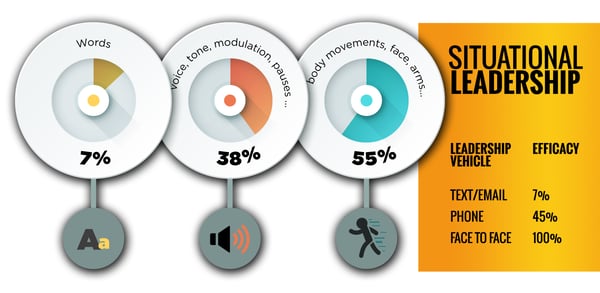Situational Leadership

The problem with leadership is that it’s super popular! The truth about leadership is not every situation needs leadership. Leadership is only necessary when change is eminent or desired. Situational leadership is understanding “how much” and “what kind” of leadership is best for a situation. Asking someone to pick up the copies at Office Depot on their way into the office requires zero leadership skill, because there is no emotional impact. Telling that same person that their job has changed because of a company reorg, requires a ton of leadership because their world changed.
When we talk about situational leadership we need to start by understanding Professors Albert Mehrabian’s Communication Model. The model above depicts the amount of emotion we can pick up from words, tone of voice and body language. When it comes to leadership, understanding how people are feeling is important. It’s also important for our followers to see and hear how we are feeling. They want to know if we are being sincere, if we care about them, etc. These emotions are mostly conveyed via tone of voice 38% and body language 55%.
On the right side of the model above, we have taken the % of emotion conveyed by each communication vehicle and turned that into a model for Leadership Effectiveness. If you need something simple done, like picking up the copies on the way into the office, email or text message will suffice. If you need to lead someone through a change, you will only be able to perceive 45% of what they are thinking/feeling over the phone. And in turn, they will only be able to perceive 45% of what you are thinking/feeling. Face to face will always give you the best chance of effectively leading your team members. The model above can be used to assess a situation and then employ the communication vehicle that will achieve the best results. Remember, the more emotional the situation, the more leadership is necessary.



